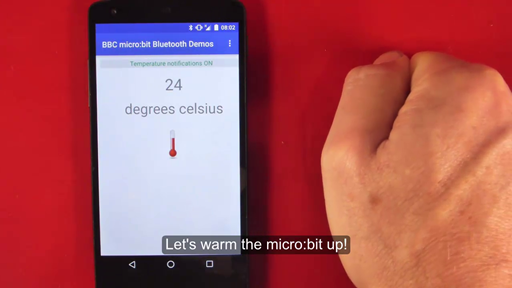Bluetooth Temperature Service¶
Introduction¶
This Bluetooth service is an optional part of the standard bluetooth profile for the micro:bit. It is a passive service, that can operate transparently in the background as your main program is running. It provides live temperature data to a connected Bluetooth master device such as a smartphone. You do not need to explicity address an API on the service to achieve this. Please note that the temperature data is inferred from the die temperature of the Nordic nrf51822 CPU. Whilst this sensor has a high precision, it is not calibrated, so will exhibit a linear shift (although changes in temperature will be accurate). See MicroBitThermometer for informaiton on the API to allow calibration.
Enabling the Service¶
This service is disabled by default. To enable the service, simply create an instance of this class in your program, at any time after the uBit object has been initialised:
new MicroBitTemperatureService(*uBit.ble, uBit.thermometer);
Note
Using Bluetooth services is memory hungry. By default, some of the memory normally used by Nordic's Bluetooth protocol stack (known as a SoftDevice), is reclaimed by the micro:bit runtime as general purpose memory for your applications. if you enable more Bluetooth services, then you may need to provide more memory back to Soft Device to ensure proper operation. If after enabling this service your Bluetooth applicaiton cannot access the service reliably, you should consider increasing the value of MICROBIT_SD_GATT_TABLE_SIZE in your inc/MicroBitConfig.h. The more service you add, the larger this will need to be, up to the limit defined in MicroBitConfig.h.
Bluetooth Service Specification¶
Please see the micro:bit Bluetooth profile specification.
Example Applications for Android/IOS/Android¶
General Procedures¶
micro:bit has an LED display with 5 rows and 5 columns i.e. 25 LEDs in total. The Bluetooth LED service allows the entire grid to be addressed as a bitmap using the LED Matrix State characteristic which supports both read and write operations. Text strings can be sent to the micro:bit for display by writing to the LED Text characteristic and the speed with which it is scrolled can be controlled by setting a delay value in milliseconds by writing to the Scrolling Delay characteristic.
See the profile page and profile reference documentation for data format and UUID details.
Android¶

Android Bluetooth APIs¶
Android developers should make themselves familiar with the Android Bluetooth low energy APIs
microbit-ble-demo-android¶
The open source microbit-ble-demo-android application contains a full demonstration of the micro:bit Bluetooth temperature service. The main body of code for this demonstration can be found in ui.TemperatureActivity.java except for the Bluetooth operations themselves which are in bluetooth.BleAdapterService which acts as a kind of higher level Bluetooth API for activities to use without needing to directly concern themselves too closely with the Android APIs themselves. In most cases, operations are asynchronous so that the activity code initiates a Bluetooth operation by calling one of the methods in bluetooth.BleAdapterService (e.g. readCharacteristic(....) ) and later receives a message containing the result of the operation from this object via a Handler object. The message is examined in the Handler code and acted upon.
Key parts of the button demonstration in this application are explained next.
In bluetooth.BleAdapterService¶
public static String TEMPERATURESERVICE_SERVICE_UUID = "E95D6100251D470AA062FA1922DFA9A8";
public static String TEMPERATURE_CHARACTERISTIC_UUID = "E95D9250251D470AA062FA1922DFA9A8";
In ui.TemperatureActivity¶
// enable temperature notifications
bluetooth_le_adapter.setNotificationsState(
Utility.normaliseUUID(BleAdapterService.TEMPERATURESERVICE_SERVICE_UUID),
Utility.normaliseUUID(BleAdapterService.TEMPERATURE_CHARACTERISTIC_UUID), true)
// receiving temperature notifications
case BleAdapterService.NOTIFICATION_RECEIVED:
bundle = msg.getData();
service_uuid = bundle.getString(BleAdapterService.PARCEL_SERVICE_UUID);
characteristic_uuid = bundle.getString(BleAdapterService.PARCEL_CHARACTERISTIC_UUID);
b = bundle.getByteArray(BleAdapterService.PARCEL_VALUE);
byte temperature = b[0];
Log.d(Constants.TAG, "Value=" + Utility.byteArrayAsHexString(b));
if (characteristic_uuid.equalsIgnoreCase((Utility.normaliseUUID(BleAdapterService.TEMPERATURE_CHARACTERISTIC_UUID)))) {
Log.d(Constants.TAG, "Temperature received: " + temperature);
TextView temp = (TextView) TemperatureActivity.this.findViewById(R.id.temperature);
temp.setText(""+temperature);
}
break;
}
